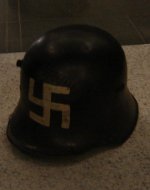Artillery_crazy
2nd Lieutenant
- Joined
- Jun 14, 2008
- Messages
- 3,536
Hi Al,
Thanks for the info on the early Air Force!
 Being more of an Artillery man, and not being focused on air warfare I would not have know all this good data.....some very famous aces!
Being more of an Artillery man, and not being focused on air warfare I would not have know all this good data.....some very famous aces!
Like I said later on and Jazzeum also mentioned, I prefer to call them the good luck symbol, which it was trully,and it still is as way back to the early centuries in Asia and early Europe....
Little Adolf gave it the sliding twist and a totally different meaning....too bad....
When young and living in India was the first time I came across the good luck symbol in many temples and was initially taken back..naturally had seen the symbol a bit slanted in my Commando and Victory books ....and at school on text books /films but never in a public space.....later on I was tought the ancient meaning of the good luck symbol .... and the twist it took in history.....


Guess that this exchange of comments that started on a reflection over a Freikorps has given me some additional information on the early flying birds too.......
Cheers
A_C
Thanks for the info on the early Air Force!
Like I said later on and Jazzeum also mentioned, I prefer to call them the good luck symbol, which it was trully,and it still is as way back to the early centuries in Asia and early Europe....
Little Adolf gave it the sliding twist and a totally different meaning....too bad....
When young and living in India was the first time I came across the good luck symbol in many temples and was initially taken back..naturally had seen the symbol a bit slanted in my Commando and Victory books ....and at school on text books /films but never in a public space.....later on I was tought the ancient meaning of the good luck symbol .... and the twist it took in history.....
Guess that this exchange of comments that started on a reflection over a Freikorps has given me some additional information on the early flying birds too.......
Cheers
A_C
Hi Luiz,
I can't post pictures but I do know of several pilots that used the emblem as a personal good luck marking. Raoul Lufbery of the Lafayette Escadrille carried a red swastika in 3 positions on his Spad 7; both sides of the fuselage and on top of the fuselage, behind the cockpit. This was Spad # S1777, flown in late 1917. German Lt. Walter Gottsch carried a white swastika on both sides of the fuselage on his Fokker Triplane, serial #419/17, while flying with Jasta 19 in spring 1918. German Lt. Eberhard Mohnicke of Jasta 11 carried swastikas on both side of Fokker Triplane #155/17 in spring 1918. German Lt. Hermann Gilly of Jasta 40 carried a white swastika on both sides of the fuselage of his Fokker D-7 in fall of 1918. There are also several Albatros pilots that used swastikas on their aircraft; Hermann Kunz of Jasta 7, white swastikas on both sides of the fuselage; Paul Billick of Jasta 12, black swastika in a white square on both sides of the fuselage; Werner Voss of Jasta 2, white swastika in a green wreath on both sides of the fuselage; Lothar Wieland of Seefrontstaffel 1 carried large black swastikas outlined in white on both sides of Albatros #7327/17; an unidentified pilot of Jasta 27, white swastikas on both sides of the fuselage; also, Jasta 23 carried a black swastika on both sides of their Albatros fighters as a unit marking during the summer of 1917 but it was replaced in August of that year.
The swastika wasn't real widespread on aircraft in the German Air Force of WW1, but it wasn't uncommon, and it was mostly used as a personal marking of individual pilots, with the exception of the above mentioned Jasta 23 where it was used as a unit marking for a while. There are also photos of swatikas on other German aircraft such as Pflaz D-3 and the Siemens-Schuckerts. I have seen the swastika used on other allied aircraft besides the Lufbery example, but haven't found the pictures yet. At any rate, there are plenty of photos of swastikas in use on aircraft in WW1. -- Al


